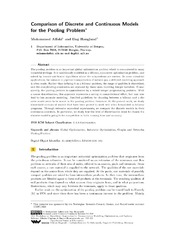Comparison of Discrete and Continuous Models for the Pooling Problem
Chapter, Peer reviewed
Published version
Permanent lenke
https://hdl.handle.net/1956/5848Utgivelsesdato
2011Metadata
Vis full innførselSamlinger
Originalversjon
https://doi.org/10.4230/oasics.atmos.2011.112Sammendrag
The pooling problem is an important global optimization problem which is encountered in many industrial settings. It is traditionally modeled as a bilinear, nonconvex optimization problem, and solved by branch-and-bound algorithms where the subproblems are convex. In some industrial applications, for instance in pipeline transportation of natural gas, a different modeling approach is often made. Rather than defining it as a bilinear problem, the range of qualities is discretized, and the complicating constraints are replaced by linear ones involving integer variables. Consequently, the pooling problem is approximated by a mixed-integer programming problem. With a coarse discretization, this approach represents a saving in computational effort, but may also lead to less accurate modeling. Justified guidelines for choosing between a bilinear and a discrete model seem to be scarce in the pooling problem literature. In the present work, we study discretized versions of models that have been proved to work well when formulated as bilinear programs. Through extensive numerical experiments, we compare the discrete models to their continuous ancestors. In particular, we study how the level of discretization must be chosen if a discrete model is going to be competitive in both running time and accuracy.

